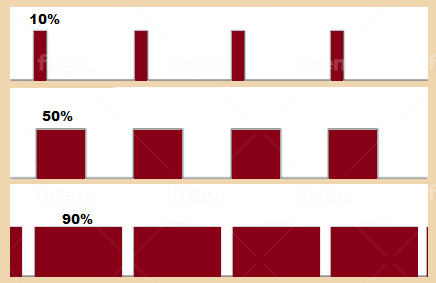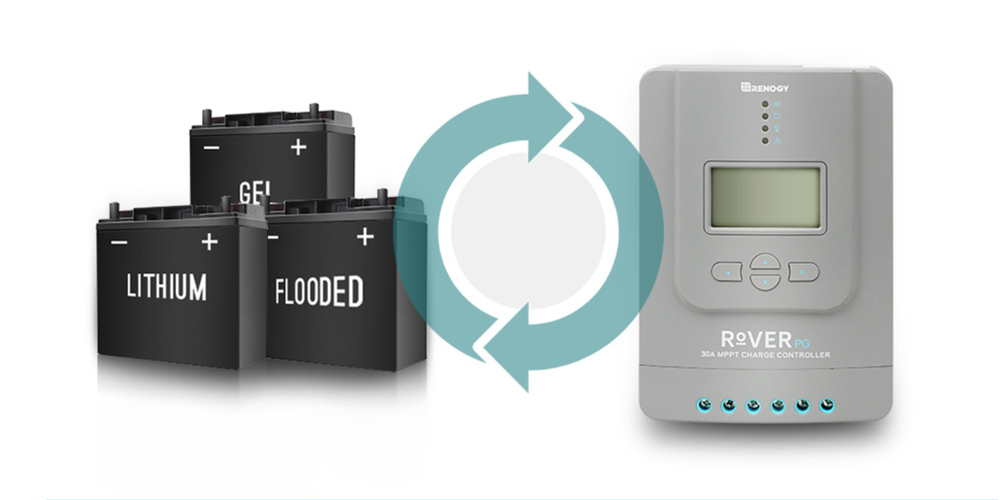MPPT and PWM Meaning Explained
A battery charge controller is absolutely a vital component of a complete solar panel system. It is engineered to protect solar batteries in several ways, for example, automatically cutting off the charging current when overcharging, or shutting off the discharge when a short circuit occurs.
There are a couple of different types of charge controllers. Among them, PWM and MPPT charge controllers are the most popular options. About the two types of charge controller, we’ve written related articles introducing the difference between MPPT and PWM charge controllers and MPPT solar charge controllers long time ago, but we think it’s still necessary to offer our avid readers an easy-to-understand guide explaining what’s MPPT technology and What’s PWM.
Here we go.
What does PWM mean?
PWM is an acronym for Pulse Width Modulation, an effective digital technology for controlling analog circuits by using the digital output of a microprocessor. By modulating the width of a series of pulses, it can produce the required waveform in shape and amplitude. In other words, it alters the duty cycle, which is the ratio of the pulse width to the pulse period, to get the required voltage and frequency. PWM technology is widely used in measurements, communications, the solar industry, and more.
What does MPPT mean?
MPPT, or Maximum Power Point Tracking-not difficult to guess from its full name-is a technology to maximize energy extraction despite the changing conditions. We always expect that our solar array can work with the best power output. However, the power output can shift as solar irradiance and temperature change constantly, as well as because of the influence of the load voltage. If no control methods are adopted, the solar array can never produce the maximum power. That’s why Maximum Power Point Tracking technology is coming in. The technology can always keep the solar array working at the highest power point.
How does the PWM charge controller work?
The PWM controller, or the Pulse Width Modulated design, is highly useful for small systems where the voltage output of the panels closely matches the voltage of the batteries. It is particularly useful where the sunlight is bright and continuous, and the batteries generally stay well-charged near the top of their capacity.
PWMs function by supplying the full available current to the batteries until they approach the maximum charged state. At that point, the internal electronic switching reduces the current to a maintenance level to keep the batteries at the peak of their condition, while avoiding damage by overcharging.
More specifically, the amount of power being delivered to the battery system is often limited by a robust little DIP Integrated Circuit chip (IC) called a 555 Timer, though there are other methods. This IC can send a signal to control when the charge control applies current to the battery and for how long.
Imagine that it has a duty cycle (the time between turning on and off right until the moment before it repeats that action) of one second. During one second we’ll imagine that the PV array could deliver five amps of current from the panels to the batteries. However, if it switched off for half a second, every second, the storage system would only receive 50% (2.5 amps) of the available current. If it was only on for 1/10th of a second, it would only provide 10% (0.5 amps) of the available power.
PWMs are not owner adjustable since they are optimized at the factory. They also cannot be used with other highly variable energy sources, such as wind turbines—strictly solar panels. When the batteries are fully charged, PWMs dissipate extra energy as heat.

Power delivery would look like the following image, providing charging energy directly proportional to the time the device is electronically switched on.
Optimally, PWM suits a bright, warm climate, and although this is the least efficient style of charge controller, it simply doesn’t matter on a smaller system. It’s ideally suited to mobile homes, converted vans, and even the modern fascination with “tiny homes”.
How does the MPPT charge controller work?
MPPTs are more sophisticated controllers than PWMs, and suited to systems of at least 400 watts. These are DC-to-DC converters that balance voltages and current between the PV source and the storage system (batteries). The efficiency of MPPTs always equals or exceeds 92% so they’ll render the maximum available energy for the conditions you are in.
Imagine you’re using a PWM charge controller and your batteries are low in the morning from overnight use, say 11 volts. Your 17.5 volts*7.5 amp (130 watt) panel is only going to be able to push 82 watts into your storage because it’s at 11 volts. You’re losing 48 watts!
These voltage mismatches between components are easily resolved by an MPPT. These superior (in this instance) charge controllers will knock down the voltage to 12 volts, bumping the current up to nearly 11 amps, resulting in you getting maximum available power to your batteries without waste.
To be clear: MPPTs read the output from the PV array, comparing it to the present battery voltages; it then alters the voltage of the PV output to maximize current to the battery system. If the voltage is significantly higher than the battery system, it can lower the voltage and increase the current; if the voltage is lower than the battery system (say because it’s partially shaded in the morning), it can drop the current to increase the voltage.

There are several methods of doing this such as incrementally increasing voltage to see if current transfer increases. If it does, it can raise the voltage further and re-measure. It keeps on doing this until the current no longer increases. If the power level changes again, it performs more checks until it reaches the ideal point.
Alternatively, methods like Incremental Conductance are more reliant on computing the voltage/current ratio, which is very effective, but more expensive since a fairly powerful onboard computer is needed.
The Takeaway
Deciding between PWM and MPPT charge controllers is important, since the cost varies significantly. You don’t want to over-buy beyond your needs, but an MPPT controller offers more versatility for expanding your system. If you expect to add more panels the MPPT may be the route to go.
Selecting among the MPPT implementations is equally important. If your array is unshaded, a much simpler system may be sufficient for your needs. If some of it is partly shaded at times during the day, a more sophisticated system will help you maximize the power you can extract from your system.
For further information, visit our Renogy site to explore the available types and designs for the perfect match for your particular and unique application. You should also feel free to contact us and let one of our experts discuss your needs and provide advice. We’d love to hear from you!
Related articles:
Solar Charge Controller Sizing and How to Choose One
Charge Controllers Demystified!
Factors to Consider when Deciding to Purchase a Charge Controller
How To Store Lithium Batteries | Other Battery Maintenance Tips








